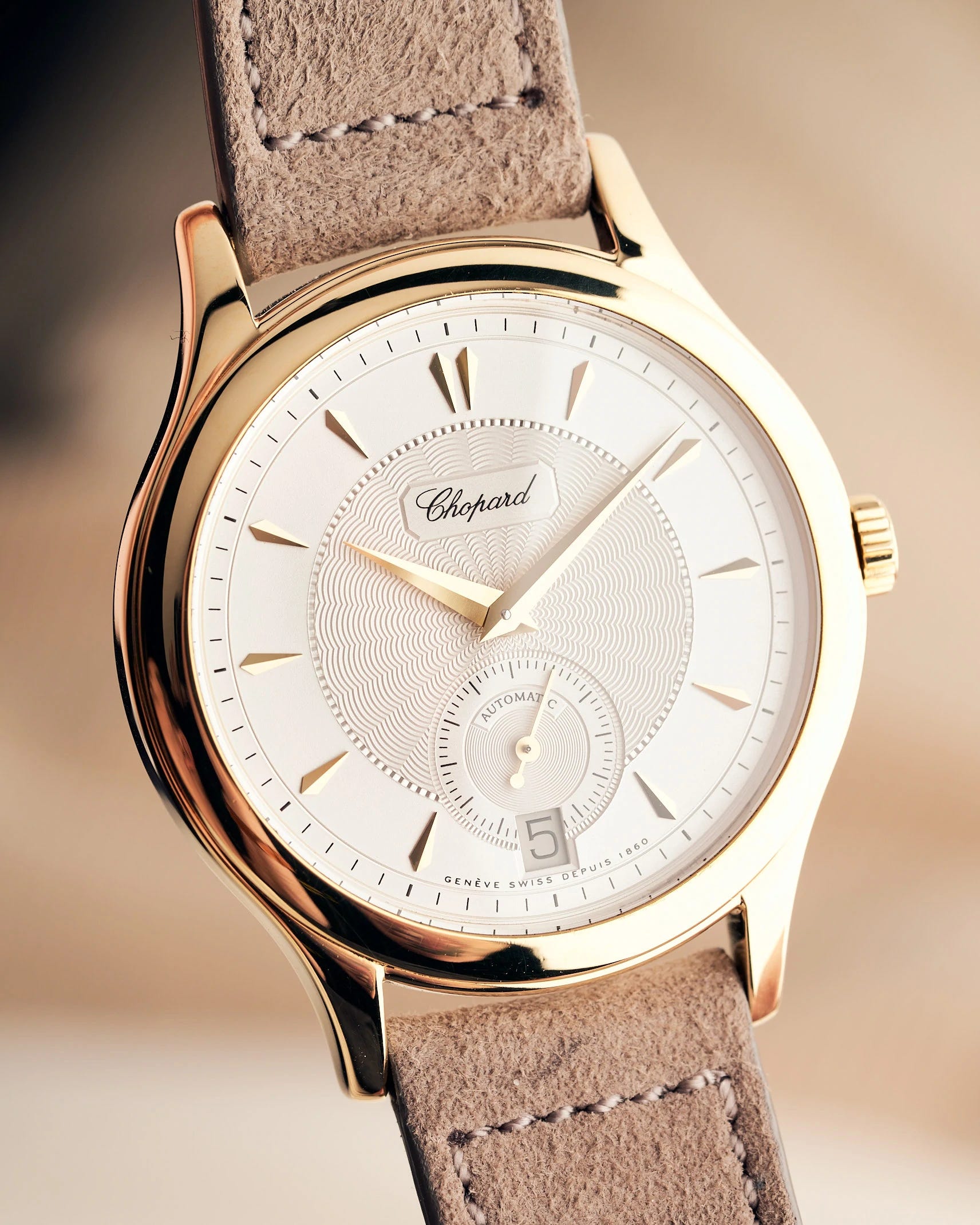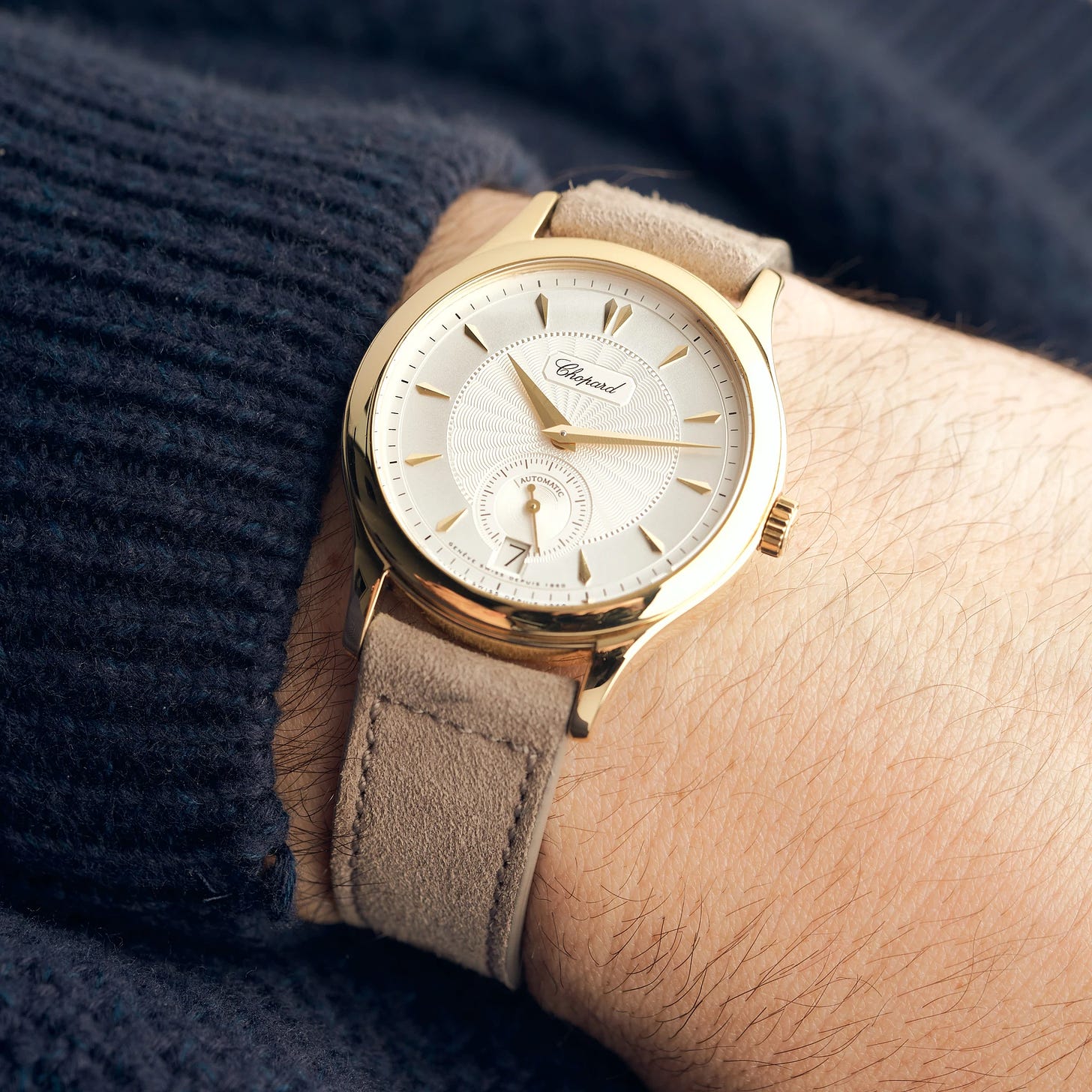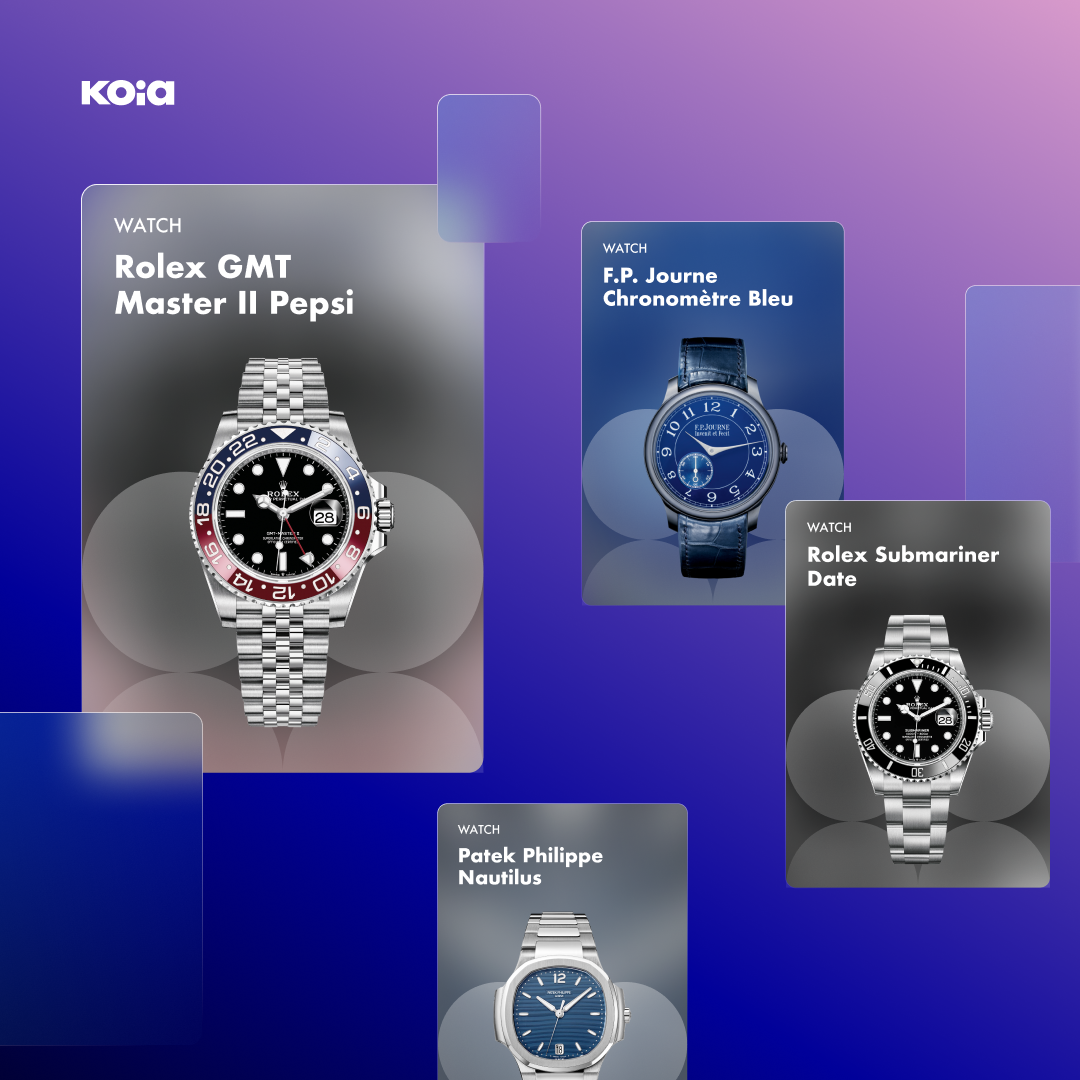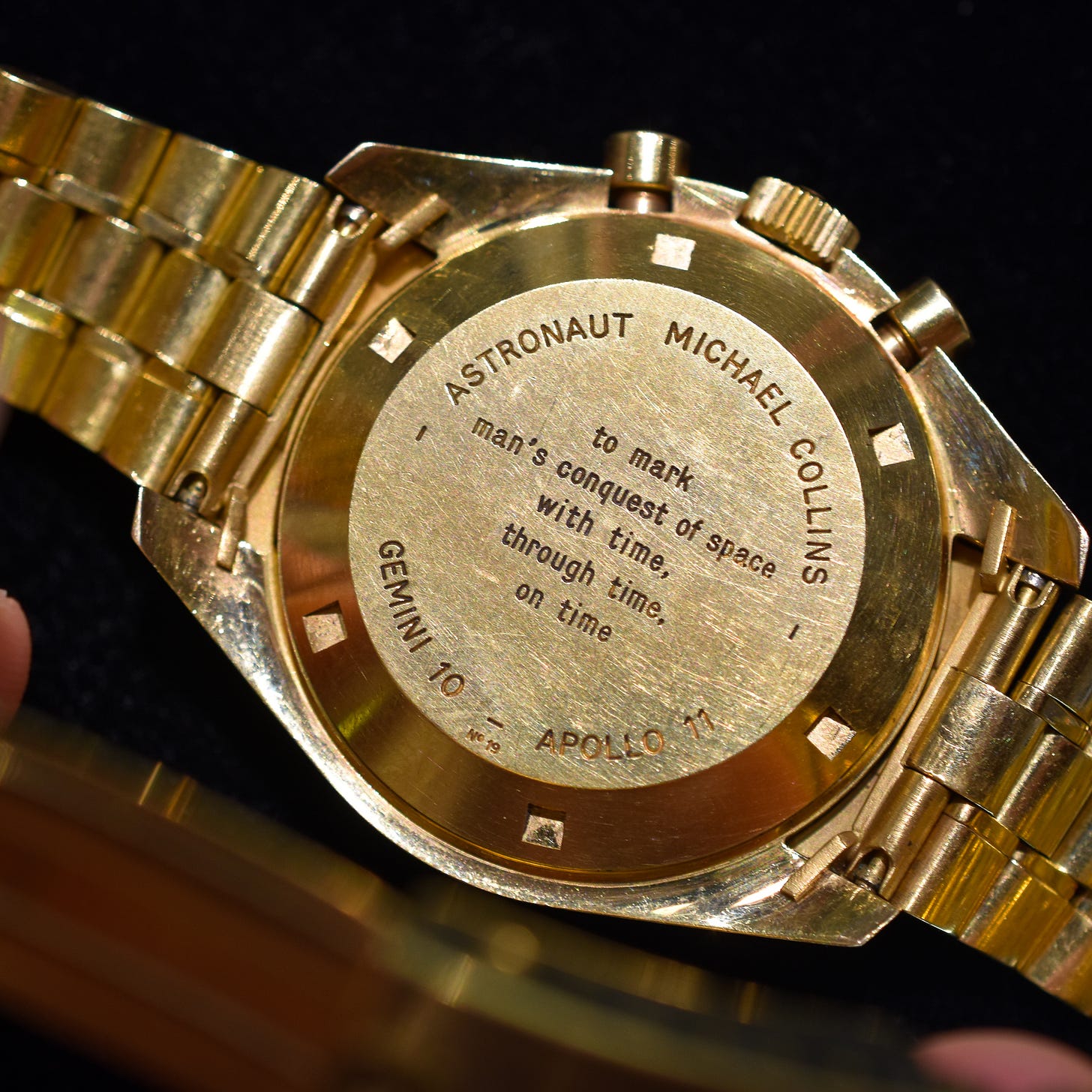How Chopard Created One of the Best Automatic Movements Ever
The stories of two astronauts and their watches
Happy Memorial Day Weekend. Swap in those bracelets and loosen up those micro-adjustments, it’s summer watch season.
In today’s ‘sletter:
How Chopard created one of the greatest automatic movements ever, the caliber 1.96 (and First Series L.U.C. 1860)
A look at the watches of not one, but two astronauts
‘Birth watches are stupid’, and the watch shortage spreads to Cartier and Tudor
I wrote an in-depth article for Subdial on what many consider to be among the best modern automatic movements ever, the Chopard caliber 1.96:
“The list of automatic movements that might seriously lay claim to the title of ‘best automatic movement ever produced’ is short. Ask around and you might get answers like the Patek Philippe 27-460, the brand’s second automatic caliber; the Jaeger-LeCoultre caliber 920 (adopted by AP, Patek, and others, and used in the original Royal Oak and Nautilus); or legendary calibers from Rolex and Omega.
But one credible answer comes from a manufacture that might surprise some: The Chopard L.U.C. caliber 1.96.”
Chopard has its historic roots as a watchmaking and jewelry house — its founder, Louis-Ulysse Chopard, was a watchmaker — but in the 1980s it re-dedicated its efforts to becoming a true manufacture capable of producing an in-house movement that rivaled those from Patek Philippe and others. It first set up shop in Fleurier, enlisting the help of master watchmaker Michel Parmigiani. But after a couple of years, Chopard brought the project completely in-house, dedicating nearly four years to creating its own in-house movement from scratch before delivering 20 prototypes of the caliber 1.96 in December 1995 (fun fact: a young Jean-Frédéric Dufour, now Rolex CEO, was charged with organizing this new in-house manufacturer).
Taking a Loupe to the Chopard Caliber 1.96
“I wanted to create a special, dedicated entity because it was obvious to go any further, we had to build a unit to produce ébauches,” CEO Karl-Friedrich Scheufele (KFS) told Europa Star in 2021. For Chopard, the goal was independence, to create a movement on par with other historic Swiss manufacturers. KFS wanted a new caliber that would be highly reliable, feature a micro-rotor and large power reserve, as well as a caliber that was aesthetically beautiful and finished to the highest degree.
The resulting caliber 1.96 featured a Breguet overcoil hairspring, swan neck regulator, and could be precisely regulated to chronometer standards, featuring a micro-rotor that wound two mainspring barrels and for a 70-hour power reserve.
Respected writer Walt Odets wrote that “[f]rom the standpoint of both design and execution, the caliber 1.96 is probably the finest automatic movement being produced in Switzerland.” In the full article, I wax poetic about the caliber 1.96’s Breguet overcoil hairspring and swan neck regulator.
Collecting the L.U.C. 1860
After the caliber 1.96 had been perfected, Chopard continued to spare no expense in developing a wristwatch fit for its mechanical masterpiece.
“Nowadays, the First Series L.U.C. 1860 is the grail of Chopard,” Chopard Director of Patrimony Juan Garcia told me.
Chopard produced the First Series of the L.U.C. 1860 with the caliber 1.96 from about 1997 through 2002. This First Series features three different references; each was to be produced in four precious metals — yellow gold, pink gold, white gold, and platinum.
Because of the degree of hand-finishing required of each 1.96, production of the caliber was extremely limited in its early years, with total output likely not close to comparing with the likes of Patek Philippe, Jaeger LeCoultre, or Lange. As a point of comparison, KFS said that in 2021 Chopard produced 4,000 movements for its entire L.U.C. line. Keep in mind that over the last twenty-five years, Chopard Manufacture has scaled up from a handful of employees to a few hundred.
In the full article, Chopard gave us new information about actual production numbers of the first generation L.U.C. 1860. While Chopard had intended to produce 1,860 examples of the original reference and 100 examples of the other two limited editions, it turns out they never finished any of these production runs, producing far fewer watches than we realized. It’s info that's only going to make collectors more aware of how rare and special the First Series L.U.C. 1860 is.
The Impact of the Chopard Caliber 1.96
The article closes:
“The L.U.C. and the caliber 1.96 are emblematic of fine watchmaking in the 1990s: a family-owned, independent house enlisting the help of a master independent watchmaker to spare no expense in developing a new micro-rotor movement that competed with the world’s best. The investment in horology came at a make-or-break moment for Chopard and its watchmaking department, and it succeeded.
‘I always like to talk about Lange, because our journey is similar,’ Director of Patrimony Garcia said. ‘Lange re-launched in 1994 with its first wristwatches. We re-started in 1996 with our first caliber, and then introduced our first 1860.’
‘Chopard had a family vision it was trying to re-create. We’re the last family business that produces both watches and jewelry, and it’s a great honor to still be independent,’ Garcia continued.
This continued independence is no doubt thanks in part to the bold decision to revive Chopard as a proud manufacture, and one capable of producing one of the best automatic movements ever, the Chopard caliber 1.96.”
In all, I wrote 3,000+ words about the story of the caliber 1.96, what makes it perhaps the greatest modern watch movement, and how to collect the original LUC 1860.
Head to Subdial to read the full article on the original Chopard LUC 1860 and caliber 1.96.
SPONSOR
Fractional Rolex Pepsi, Patek Philippe Nautilus or an Audemars Piguet Royal Oak?
Koia lets you buy, collect and trade Fractions linked to collectible assets.
At the click of a button, users can start building a collection of passion assets from just $120. Koia takes care of asset authentication, storage, and insurance, reducing all of the usual hassle. When ready, users can sell their Fractions via third-party marketplaces such as OpenSea, or vote to sell the underlying asset.
Start building your fractional watch collection via Koia.
Hands-on with astronaut Michael Collins’ Omega Speedmaster
Astronaut Michael Collins flew Apollo XI to the moon, joined by his crewmates Buzz Aldrin and Neil Armstrong. When Armstrong and Aldrin hopped into the lunar module, eventually landing on the moon to make that “one small step,” Collins stayed behind in command module Columbia.
More on the watch in a second, but I enjoyed some of these tidbits about Collins while he was alone in Columbia orbiting the moon. In his autobiography, Collins said he still felt very much a part of the mission, writing, "this venture has been structured for three men, and I consider my third to be as necessary as either of the other two". In the 48 minutes of each orbit when he was out of radio contact with Earth while Columbia passed around the far side of the Moon, the feeling he reported was not fear or loneliness, but rather "awareness, anticipation, satisfaction, confidence, almost exultation." I start to get anxious if I lose cell reception for more than five minutes, and that’s reason #4397 why I’m not an astronaut (there’s also my crippling fear of heights and flying).
Omega produced just 1,014 of these gold Speedmasters to commemorate the moon landing, the first handful of which were given to Apollo XI astronauts and team members, like Collins. It’s a huge, heavy gold watch, and after getting to put on an actual astronaut’s, it’s probably my favorite Speedmaster ever.
Michael Collins’ Omega Speedmaster is at Heritage Auction on June 1, with the current bid at $155,000.
Oh, and the caseback is great too.
THROUGH THE WIRE
Another astronaut’s watch

🧑🚀 Astronaut Scott Carpenter’s Breitling, the First Swiss Watch in Space. Scott Carpenter was the second American to orbit Earth, and for the 60th anniversary of his space flight, Breitling revealed the original prototype Cosmonaute he wore for the flight. Long missing from history, Breitling revealed it’s been in the Breitling family’s private collection since Carpenter gave it back to them after orbiting Earth in 1962.
When Carpenter splashed back down on this humble planet, he ended up stranded at sea for three hours, and his Breitling became soaked with water and the watch stopped running soon after:
“When [watchmaker and third-generation owner of Breitling,] Willy Breitling looked at the watch, he realized that he had a ‘sacred’ piece of history that should not be rebuilt or restored. It had stopped at 21:46 on the afternoon of May 24, 1962, and that was an important moment in the history of the United States space program and in the history of Breiting and the Swiss watch industry. This was the watch Carpenter wore on his flight and that ran until he had been rescued. This was the "original" watch, and like every other watch, it could only be truly original if left undisturbed. Willy Breitling chose to leave this sacred object untouched, not even removing the sludge from inside the watch or cleaning the crystal.”
Jeff Stein’s got the story on Hodinkee, and our friends Charlie and Eric have some major photos of the other-worldly watches over on Wind Vintage.
📉 Global Rolex Shortage Spreads to Cartier, Tudor. “We can’t get enough Santos. We can’t get enough Tudor, particularly the chronograph models,” Watches of Switzerland said on its latest earnings call. The only shortage more concerning than baby formula? (Bloomberg)
📦 Out of the Box. On Significant Watches, we’ve ranted about big, useless watch boxes before. But one of my favorite boxes comes from Nomos: they’re small, slim, and fit in a drawer. And now, you can buy one of these slim boxes that fits 6 whole watches. 🏃 How my Apple Watch turned me against myself. ✏️Has minimalism in watch design gone too far?
❣️ As always, tap the heart if you liked this edition. -Tony










